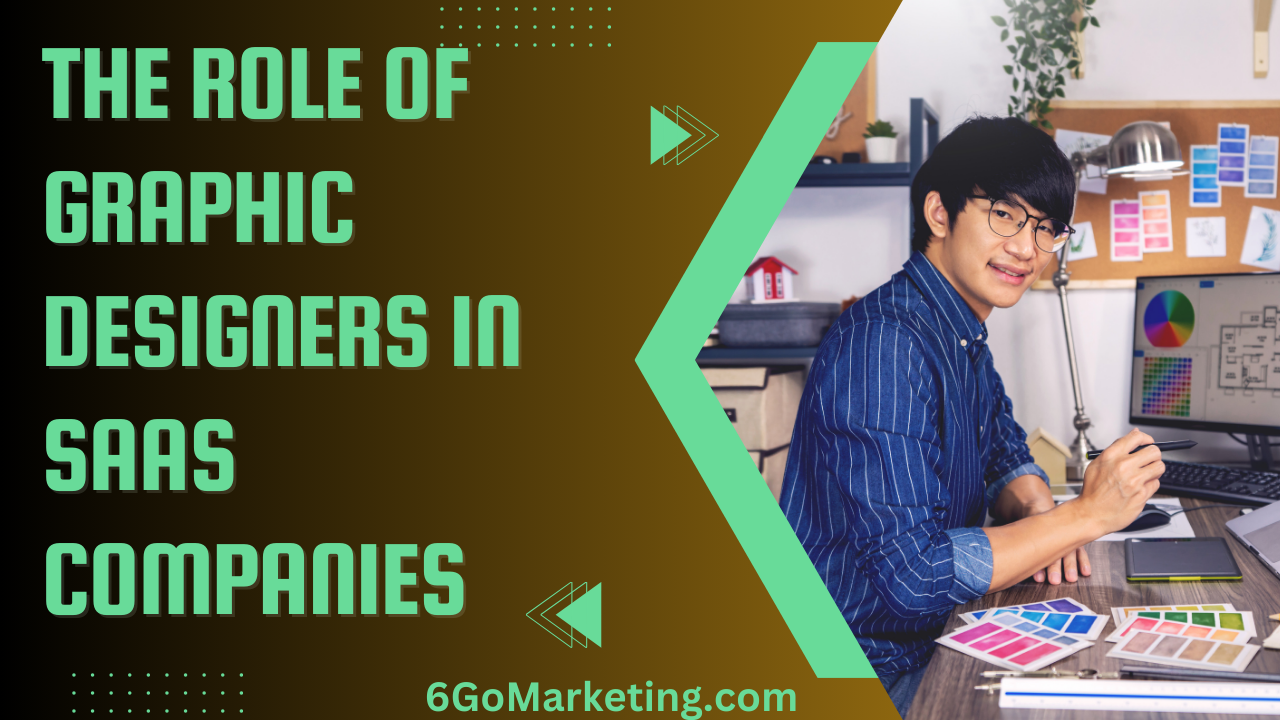In the dynamic world of Software as a Service (SaaS), the importance of user experience cannot be overstated. While developers and product managers often take center stage, graphic designers play a crucial role in shaping the user experience (UX) and the overall success of SaaS products.
Graphic designers are responsible for translating complex ideas into visually compelling and intuitive interfaces. This post explores the multifaceted role of graphic designers in SaaS companies, emphasizing their impact on product design, branding, marketing, and user retention.
The Importance of Design in SaaS
In the competitive SaaS market, where users have countless options, the first impression often determines whether a user will stay or leave. A well-designed product that offers an intuitive user interface (UI) and seamless user experience (UX) is essential for customer retention.
According to a study by Adobe, 38% of people will stop engaging with a website if the content or layout is unattractive. This statistic highlights the critical role that graphic designers play in creating engaging and effective SaaS products.
| Statistic | Data |
| Users who stop engaging due to poor design | 38% |
| Average time users take to form an opinion about a website | 0.05 seconds |
| Impact of a good UI on conversion rates | Up to 200% increase |
The Role of Graphic Designers in Product Development
Graphic designers are integral to the product development process in SaaS companies. Their responsibilities often include:
- User Interface (UI) Design: Graphic designers create the visual elements of the software interface. They ensure that the product is aesthetically pleasing and that every visual component, from buttons to icons, aligns with the overall brand and UX goals. Also, by leveraging custom Java app development, businesses can enhance user experience in numerous ways.
- User Experience (UX) Design: While UX design is a specialized field, graphic designers often collaborate closely with UX designers. They help design workflows and wireframes that guide users through the product in an intuitive way.
- Prototyping and Testing: Graphic designers often create prototypes to test design concepts. These prototypes are essential for gathering feedback from users and stakeholders, allowing the product team to make necessary adjustments before final development.
- Visual Consistency: Consistency is key in SaaS design. Graphic designers ensure that all elements of the software, including fonts, colors, and imagery, are consistent across all platforms and devices. This consistency helps in building trust and familiarity with users.
The Impact on Branding and Identity
In addition to product design, graphic designers play a crucial role in building and maintaining the brand identity of a SaaS company. A strong brand identity differentiates a SaaS product from its competitors and fosters a connection with users.
- Logo and Brand Design: The logo is often the first element of a brand that users encounter. Graphic designers, using the best graphic design apps, create logos that encapsulate the company’s values, mission, and personality. A well-designed logo can make a lasting impression and contribute to brand recognition.
- Visual Brand Guidelines: Graphic designers develop comprehensive visual brand guidelines that outline the correct usage of the company’s logo, typography, color schemes, and imagery. These guidelines ensure that all visual content produced by the company is consistent and aligned with the brand’s identity.
- Marketing Collateral: Beyond the product itself, graphic designers create marketing materials, including social media graphics, email templates, and promotional banners. These materials must not only be visually appealing but also resonate with the target audience and convey the brand’s message effectively.
- Customer Perception: According to a study by Lucidpress, consistent brand presentation across all platforms increases revenue by up to 23%. This statistic underlines the importance of a unified brand identity, which is largely the responsibility of graphic designers.
| Role | Responsibility | Impact on SaaS |
| Logo Design | Creating a memorable logo | Brand recognition and recall |
| Visual Brand Guidelines | Standardizing visual elements | Consistency across platforms |
| Marketing Collateral | Designing promotional materials | Increased engagement and conversions |
| Customer Perception | Influencing how customers view the brand | Higher trust and brand loyalty |
Collaboration with Other Teams
Graphic designers do not work in isolation; they collaborate closely with various departments within a SaaS company. This cross-functional collaboration is vital for creating a cohesive product and brand experience.
Collaboration with Product Managers: Product managers and graphic designers work together to ensure that the product meets both business objectives and user needs. While product managers focus on functionality, graphic designers ensure that the product is visually appealing and easy to use.
Collaboration with Developers: Developers rely on graphic designers to provide detailed design specifications and assets. This collaboration ensures that the final product reflects the designer’s vision while being technically feasible.
Collaboration with Marketing Teams: Graphic designers collaborate with marketing teams to create campaigns that align with the company’s brand and target audience. Designers ensure that all visual content, from landing pages to social media posts, maintains a consistent look and feel.
Collaboration with Customer Support: Designers may work with customer support teams to design help guides, FAQs, and other resources that enhance the user experience. A well-designed support system can reduce the burden on customer service and improve user satisfaction.
The Role in User Onboarding and Retention
User onboarding is a critical phase for SaaS companies. A poor onboarding experience can lead to high churn rates, while a well-designed onboarding process can set the stage for long-term customer retention. This is why, in mobile app development, graphic designers play a crucial role in crafting effective onboarding experiences.
Onboarding Screens: Designers create onboarding screens that guide users through the initial setup of the product. These screens should be visually appealing, informative, and easy to navigate.
Interactive Tutorials: Interactive tutorials designed by graphic designers can help users understand how to use the product’s features effectively. These tutorials often incorporate animations and illustrations that make the learning process engaging.
Feedback Mechanisms: Graphic designers help create feedback mechanisms, such as pop-ups and in-app messaging, that provide users with timely tips and support. This continuous engagement can improve user retention.
Retention Strategies: Retaining users is crucial for the success of any SaaS product. Graphic designers contribute to retention strategies by creating personalized experiences, such as customized dashboards and reports that resonate with individual users.
| Onboarding Element | Designer’s Role | Impact on User Experience |
| Onboarding Screens | Designing visually appealing screens | Smooth and engaging initial experience |
| Interactive Tutorials | Creating engaging and informative tutorials | Better user understanding and adoption |
| Feedback Mechanisms | Designing in-app messages and tips | Continuous support and engagement |
| Personalized Experiences | Customizing dashboards and reports | Increased user satisfaction and retention |
The Evolution of the Graphic Designer’s Role in SaaS
The role of graphic designers in SaaS companies has evolved significantly over the years. Initially, designers were often seen as “pixel pushers” who were brought in to make things look good. However, as the SaaS industry has matured, the role of graphic designers has expanded to encompass a wide range of responsibilities, from product design to brand strategy.
From Visual Designers to UX/UI Experts: The modern graphic designer in a SaaS company is often well-versed in UX/UI principles. They are not just concerned with aesthetics but also with how users interact with the product. This shift has made designers essential members of the product development team.
Data-Driven Design: In today’s data-driven world, graphic designers increasingly rely on analytics and user feedback to inform their designs. This approach ensures that the design decisions are based on real user behavior rather than assumptions.
Cross-Platform Design: With the rise of mobile apps and responsive web design, graphic designers must create designs that work seamlessly across different devices and screen sizes. This requires a deep understanding of both the technical and aesthetic aspects of design.
Strategic Partners: Graphic designers are now seen as strategic partners in SaaS companies. They are involved in high-level decisions about product direction, branding, and customer experience. This elevated role reflects the growing recognition of design as a critical factor in business success.
Case Study: Slack’s Design Success
Slack is a prime example of a SaaS company that has leveraged design to achieve remarkable success. The platform’s intuitive design, playful branding, and seamless user experience have made it a favorite among users. Slack’s design team focused on creating a product that was not only functional but also delightful to use.
Consistent Branding: Slack’s design team developed a consistent visual identity that is reflected across all touchpoints, from the app interface to marketing materials.
User-Centered Design: The design team at Slack prioritized user needs, creating features and workflows that make collaboration easy and enjoyable.
Attention to Detail: Small design details, such as Slack’s custom emojis and loading animations, contribute to a positive user experience and reinforce the brand’s personality.
Slack’s success underscores the importance of design in SaaS, showing that a well-designed product can lead to widespread adoption and customer loyalty.
Challenges Faced by Graphic Designers in SaaS
While the role of graphic designers in SaaS companies is rewarding, it also comes with its own set of challenges:
Balancing Aesthetics and Functionality: Designers must strike a balance between creating a visually appealing product and ensuring that it is functional and easy to use.
Keeping Up with Trends: The design industry is constantly evolving, with new trends and technologies emerging regularly. Designers must stay updated to create products that are modern and relevant, while also ensuring that their designs remain timeless and effective over the long term. This balancing act can be challenging, especially in a fast-paced environment like SaaS.
Collaboration and Communication: Graphic designers often work with multiple teams, including developers, product managers, and marketers. Effective communication and collaboration are crucial to ensuring that everyone is aligned on the vision and goals of the project. Miscommunication or conflicting priorities can lead to delays and frustration.
Limited Resources: In some SaaS companies, particularly startups, designers may face limitations in terms of time, budget, and resources. This can make it difficult to create the high-quality designs that are necessary to stand out in a competitive market. Designers must be resourceful and creative to deliver impactful designs within these constraints.
User Feedback and Iteration: SaaS products are often updated and iterated based on user feedback. Designers must be open to making changes and improvements, even if it means revisiting and refining designs multiple times. While this iterative process is essential for creating user-centric products, it can be challenging to balance feedback with the original design vision.
The Future of Graphic Design in SaaS
The role of graphic designers in SaaS is likely to continue evolving as the industry grows and new technologies emerge. Some trends that may shape the future of graphic design in SaaS include:
AI and Automation: Artificial intelligence and automation are beginning to influence design tools and processes. Designers may increasingly use AI-powered tools to streamline tasks such as prototyping, testing, and even generating design variations. However, the human element of creativity and empathy will remain irreplaceable.
Personalization: As SaaS products become more personalized, designers will need to create flexible and adaptable designs that can cater to individual user preferences. This may involve designing modular components that can be dynamically adjusted based on user behavior and data.
Sustainability in Design: As awareness of environmental issues grows, designers may be tasked with creating more sustainable and eco-friendly designs. This could involve using fewer resources, optimizing performance to reduce energy consumption, and promoting digital sustainability through responsible design practices.
Inclusive Design: Inclusive design, which ensures that products are accessible to users of all abilities and backgrounds, will become increasingly important. Graphic designers will need to prioritize accessibility in their designs, ensuring that SaaS products can be used by a diverse range of users.
Augmented Reality (AR) and Virtual Reality (VR): As AR and VR technologies advance, graphic designers may find themselves designing for immersive experiences. These technologies have the potential to transform how users interact with SaaS products, and designers will need to adapt their skills to create compelling and intuitive AR/VR interfaces.
Conclusion
Graphic designers are essential to the success of SaaS companies, playing a critical role in product design, branding, user experience, and customer retention. Their work goes beyond aesthetics; it involves creating intuitive and engaging experiences that resonate with users and reflect the company’s brand values. As the SaaS industry continues to evolve, the role of graphic designers will become even more important, with new challenges and opportunities emerging.
By collaborating with other teams, staying updated with industry trends, and embracing new technologies, graphic designers can continue to create products that stand out in the competitive SaaS landscape.
Their work not only enhances the user experience but also drives business success by fostering brand loyalty, improving customer retention, and ultimately contributing to the growth and profitability of SaaS companies.
In conclusion, the role of graphic designers in SaaS is multifaceted and dynamic. Their ability to combine creativity with functionality, branding with usability, and innovation with consistency makes them indispensable to any successful SaaS company.
As the industry grows, so too will the opportunities for designers to make a lasting impact on the products and companies they work for, ensuring that design remains at the forefront of the SaaS revolution.










